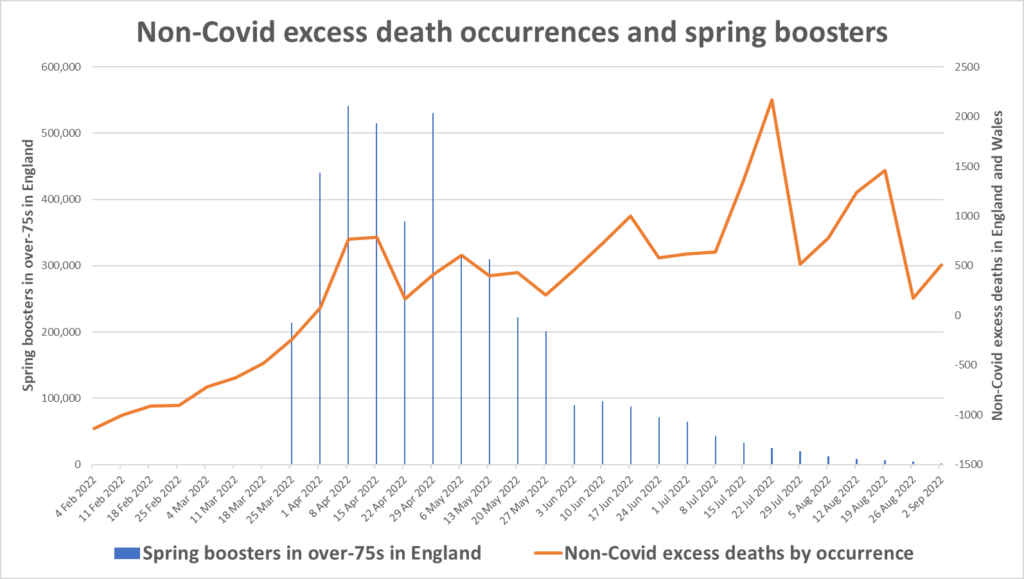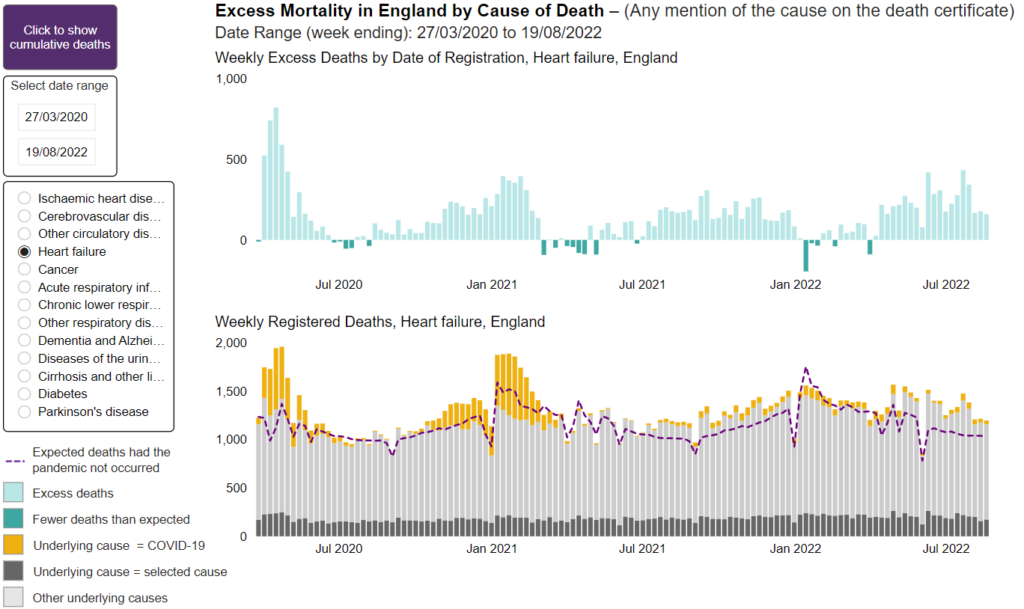The wave of excess non-Covid deaths continues. The latest Government figures from the ONS, published this morning, take the tally of excess deaths from causes other than COVID-19 to 17,839 since April 23rd, when the recent surge began. This is 9.5% more deaths than expected, based on an average of the previous five years. Overall excess deaths, including Covid deaths, have been 13% higher than expected during the period.
In the week ending September 9th, the most recent week for which data are available, 10,753 deaths were registered in England and Wales, which is 938 (9.6%) above the five-year average for the week. Of these, 365 mentioned COVID-19 on the death certificate as a contributory cause and 223 mentioned COVID-19 as underlying cause, leaving 715 deaths from a different underlying cause.

Here are the excess non-Covid deaths by date of occurrence since February, plotted with the spring vaccine booster rollout figures owing to an apparent correlation, at least at the initial stages.

The disturbing trend of surging excess non-Covid deaths is not restricted to the U.K., but is also being seen in Australia and across Europe.
Investigations into what lies behind the worrying pattern are now belatedly appearing, though notably none as yet include vaccination status.
Stuart McDonald, Co-Chair of the COVID-19 Actuaries Response Group, has written an analysis, in which he notes that many of the deaths are due to cardiovascular disease (CVD). He suggests that the causes are likely to lie in the impact of the virus on the heart or in problems with accessing healthcare both currently and during the pandemic.
The ‘Swiss Doctor’ (i.e., Swiss Policy Research) has similarly argued that Covid itself it likely to blame (alongside heatwaves and wrong baselines), noting the strong temporal association between when the non-Covid excess occurs and Covid waves.
This week the Office for National Statistics has also published its latest report on excess deaths. Sarah Caul, ONS Head of Mortality Analysis, implied the virus is likely to blame, saying the excess non-Covid deaths in 2022 have been “driven by higher than expected numbers of deaths since March, which could be caused by a combination of factors. Across March, April and May we saw increases in deaths due to cardiac arrhythmias [irregular heartbeat], predominantly among those aged 80 and above. Further work needs to be done to understand any link between the long-term effects of Covid and increasing cardiac deaths.”
The ONS report shows that excess mortality in May and June was 15.4% and 8.6% above average respectively, with 76% of the excess deaths in May and 82% in June not being due to COVID-19.
Ms. Caul suggested that the mild winter may have resulted in some “mortality displacement”, with below average deaths during the winter leading to above average deaths now – though this seems to ignore somewhat the 150,000 excess deaths in the past two and a half years, which will have caused substantial mortality displacement of their own, in the opposite direction.
Could it be the lack of access to healthcare that’s causing the deaths, as suggested by Stuart McDonald? It can’t be helping, of course. But since heart problems (and more generally cardiovascular disease) are among the main causes, the central question is why more people are dying of CVD. Is this purely or mainly due to lack of access to treatment? This seems unlikely. It’s true that NHS elective and emergency admissions dipped considerably during 2020 and 2021, as shown below.
The great length of the current hospital admission delays are also well-known. These are mainly caused by ‘bed-blocking’ preventing the movement of patients efficiently through the hospital system, which has a number of causes, but increased demand (patients are sicker) is an important factor. Some of this is self-reinforcing – the delays are making people sicker, causing more delays. But there must also be an independent driver of demand, something that is a cause of serious cardiovascular disease. No doubt some of this is a result of missed operations and procedures during 2020 and 2021. However, the preponderance of CVD-related deaths and the lack of excess cancer deaths suggests that something besides lack of access to healthcare is going on (though admittedly the cancer deaths may be on their way).
It’s also relevant here that the excess cardiovascular non-Covid deaths didn’t begin until mid-2021 and were not a feature of the first 16 months of the pandemic.

They began around the same time as the Delta variant emerged, and have largely continued since, albeit with a gap during the winter when the mildness of Omicron (in the U.K. at least) resulted in a low-mortality winter. The temporal association with the Delta and Omicron waves is what leads many to suggest that the virus is triggering the deaths in some way. It’s also well known that cardiovascular deaths are often associated with acute respiratory infection, and Covid is no exception (though whether this risk continues longer term is disputed, and limited autopsy evidence suggests that Covid, when fatal as a respiratory infection, does not routinely attack the heart).
The question, though, is why have cardiovascular deaths associated with Covid waves become much more pronounced since mid-2021?
The Japanese Government has noted this association, reporting that 89% of those who died of Covid in the latest Omicron wave had only moderate respiratory symptoms, up from 57% in 2021’s Delta wave. It added that a smaller percentage of COVID-19 patients have developed serious pneumonia as the vaccination rate has increased, while more have died because the coronavirus “causes their pre-existing conditions to worsen”. This seems to indicate that the vaccine is playing a role in the shift from textbook respiratory Covid deaths to deaths from other causes triggered by the virus.
In Singapore, the Ministry of Health has analysed the country’s excess deaths and found that the gap between Covid deaths and excess deaths can be explained by “deaths in patients recently infected with COVID-19 in the past 90 days”. Also, in “persons without recent infection, no additional excess deaths were found” – seeming to confirm the link with the virus, at least in Singapore. The Ministry also looked at vaccination status, but only of the ‘with Covid’ (test-positive) deaths. It found the unvaccinated were over-represented – but we already know the unvaccinated are over-represented in test-positive Covid deaths. It’s the non-Covid (test-negative) deaths that there is a big question mark over, and which the report from Japan suggests may be linked with the vaccine.
Many researchers have homed in on the virus’s spike protein as being peculiarly harmful to the heart and circulatory system. Dr. Zhiqiang Lin, an Assistant Professor of Cardiology at the Masonic Medical Research Institute in New York, exposed human heart tissue in the lab to spike proteins from COVID-19 and HCoV-NL63, a coronavirus that infects the respiratory system without harming hearts, and found the Covid spike sparks an immune response in heart cells whereas the other coronavirus did not. He believes this causes excessive inflammation which damages heart cells and causes myocarditis.
Dr. David Strain, a Senior Clinical Lecturer at the University of Exeter who specialises in viral infections, argues that there is a danger period for cardiovascular disease of six to eight weeks after infection: “This is the period when we see rates of heart attacks, strokes and blood clots going up. During this post-infection danger period, Covid picks on your weakest parts, such as your heart and arteries.” He says there is worrying evidence suggesting that the virus can hide dormant in our bodies for months. “If the virus can hide in the body then anything that weakens a person’s immune defences – such as physical stress, infection or reinfection with another strain of Covid – may allow the virus to re-emerge. There is evidence to suggest Long Covid can be caused by the virus persisting, and having surges subsequently may cause cardiovascular disease.”
There is certainly evidence that the spike protein can persist in individuals and is linked with immune inflammation and Long Covid symptoms – a diagnostic has even been launched based on this research. I am not aware of evidence that the virus as a whole can hide dormant in the body and resurge later, though perhaps I have missed those studies. But with the stress on the role of the spike protein in causing heart inflammation there is a stark omission from much of this discussion, namely the Covid vaccines, which are injected into muscle, can get into the blood, and induce cells to produce the spike protein in quantity wherever they end up. Spike protein from the vaccines has also been shown by the same researchers who developed the Long Covid diagnostic to persist in the body for weeks or months and cause immune inflammation; the researchers even said they couldn’t be confident their findings about Long Covid weren’t due to spike protein from vaccination rather than infection.
The Covid vaccines are known to cause serious adverse effects on the heart, with one study in Thailand (which is yet to be peer-reviewed) finding cardiovascular adverse effects in around a third of teenagers following Pfizer vaccination, and heart inflammation in one in 43. Limited autopsy evidence also confirms fatal effects of vaccination on the heart.
In addition to this, there is growing evidence that the spike protein can cause autoimmune damage owing to its similarity to human proteins, as the immune system attacks its own tissue. If the spike protein (or the mRNA producing it) is remaining in the body for weeks or months and causing immune inflammation, including in the heart, could an infection with the virus, by triggering a full-scale immune response, spark a heightened immune reaction to the persisting spike protein in and around the heart (and elsewhere) and cause serious injury? Such mechanisms are certainly possible.
A picture is emerging here of Covid waves since the vaccine rollout triggering waves of heart deaths. It remains conceivable that the vaccines are playing only a limited role in this, but on the currently available evidence that is looking increasingly unlikely. There is still a dearth of reliable data published on all-cause mortality by vaccination status (the ONS published some, but as Professor Norman Fenton pointed out, the dataset is missing thousands of deaths, miscategorises deaths and underestimates the size of the unvaccinated population).
What we do know is that Sarah Caul from the ONS said that the excess heart deaths since the spring have been “predominantly among those aged 80 and above”, a cohort we know to be highly vaccinated – 96% with at least one dose and over 78% with a fourth booster dose since the spring.
What the authorities need to do now is stop making excuses and release the all-cause mortality data by vaccination status – including those vaccinated less than seven or 14 days before death, and with no missing deaths or population errors – so we can all see whether there is any relationship between vaccination status and deaths from heart diseases and other causes.
The fact that it is September 2022 and these data are still nowhere to be seen, either here or in any other country, only increases suspicions that there is something they don’t want us to see.











To join in with the discussion please make a donation to The Daily Sceptic.
Profanity and abuse will be removed and may lead to a permanent ban.